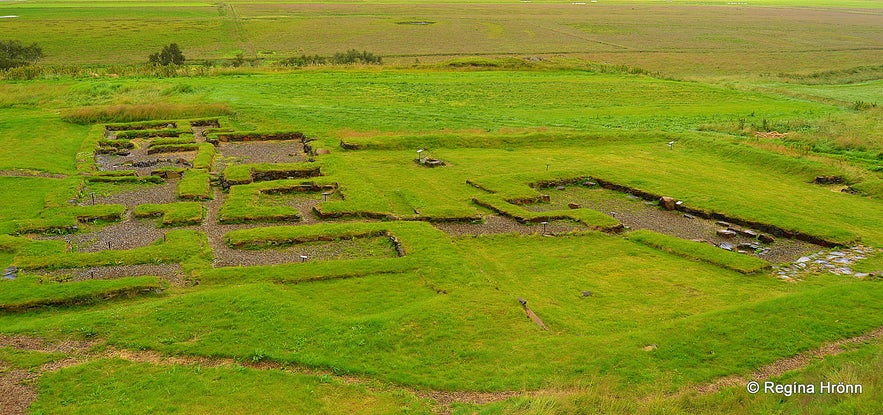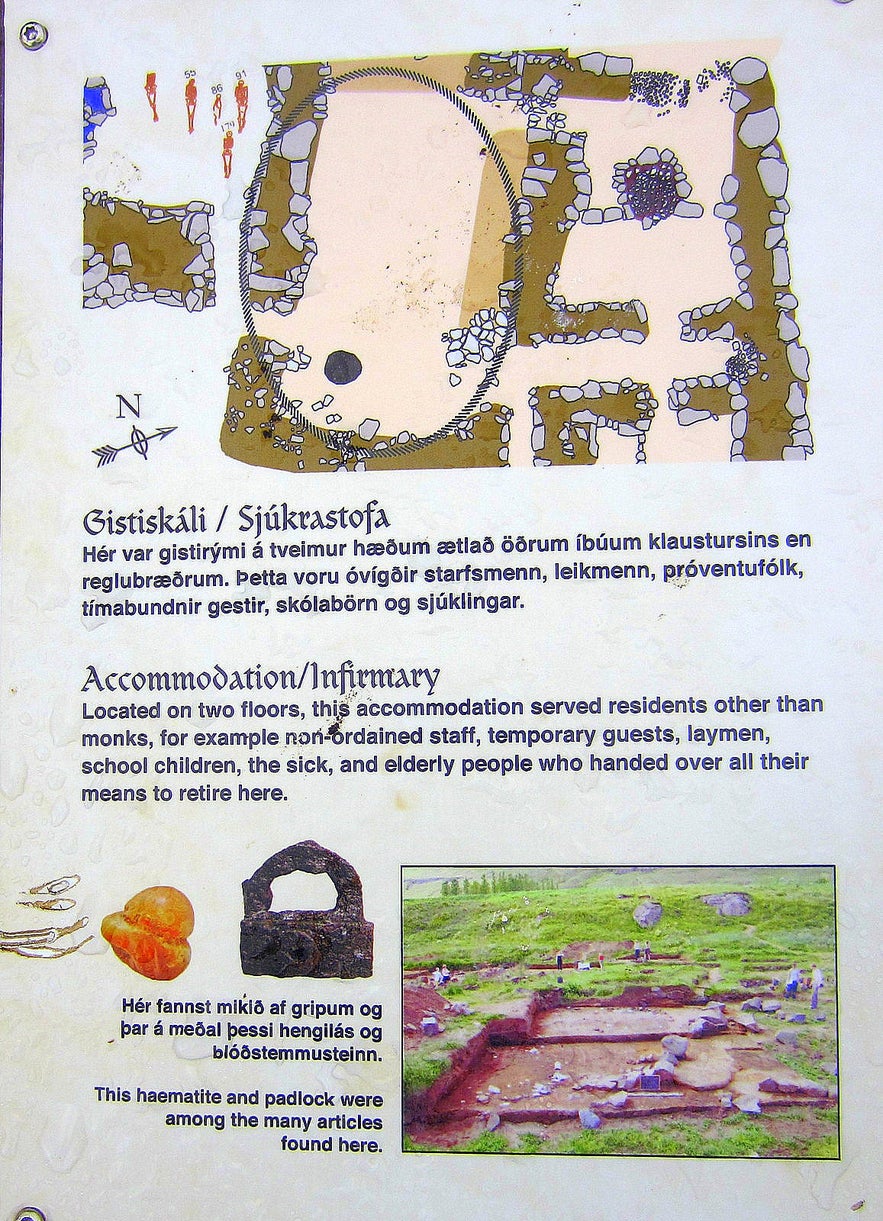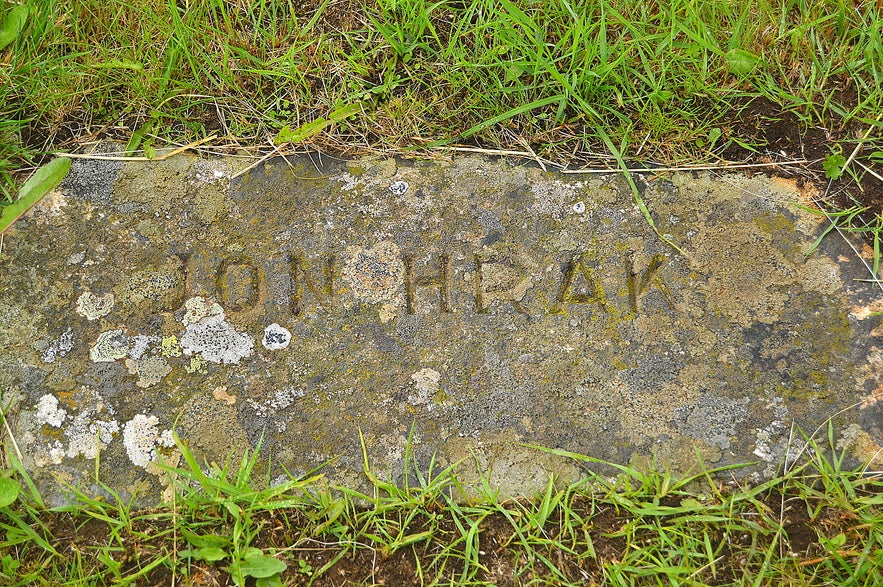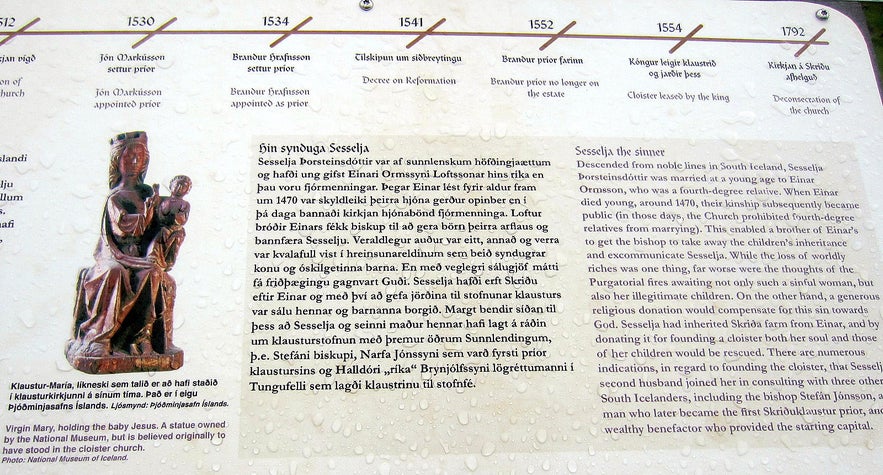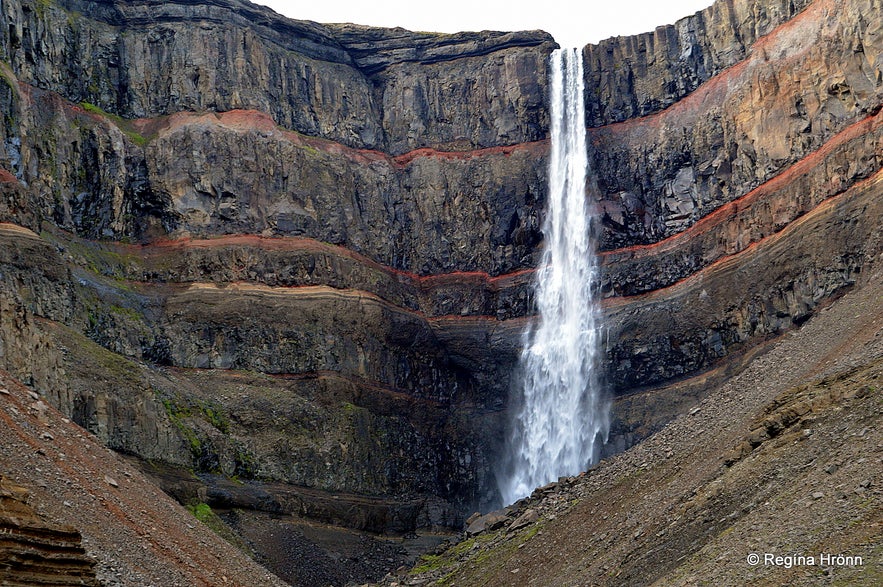
Skriðuklaustur and the Archaeological Excavations in East Iceland

Skriðuklaustur is a beautiful place to visit on your travels in East Iceland. It is a Centre of History and Culture (Gunnarsstofnun) and one of the greatest historic sites in Iceland.
The last Catholic monastery in Iceland, an Augustinian monastery, operated on this spot from 1493-1552. Its main purpose for these 60 years was to attend to the sick.
This beautiful building is the former home of the noted author Gunnar Gunnarsson (1889-1975).
Top photo: Skriðuklaustur

Visiting the beautiful Skriðuklaustur
Gunnar built this manor at Skriðuklaustur in 1939. It was designed by the German architect, Fritz Höger, who was a friend of Gunnar's. Fritz never came to Iceland, but I am sure that he was proud of how his beautiful work turned out.
It is a mixture of a European mansion and a cloister with a reference to the traditional Icelandic turf houses.
I think it is an absolutely beautiful building and love the turf roof :) The double walls have turf insulation and there are basalt rocks in the concrete walls, which give this beautiful, one-of-a-kind Icelandic building, a very distinctive look.
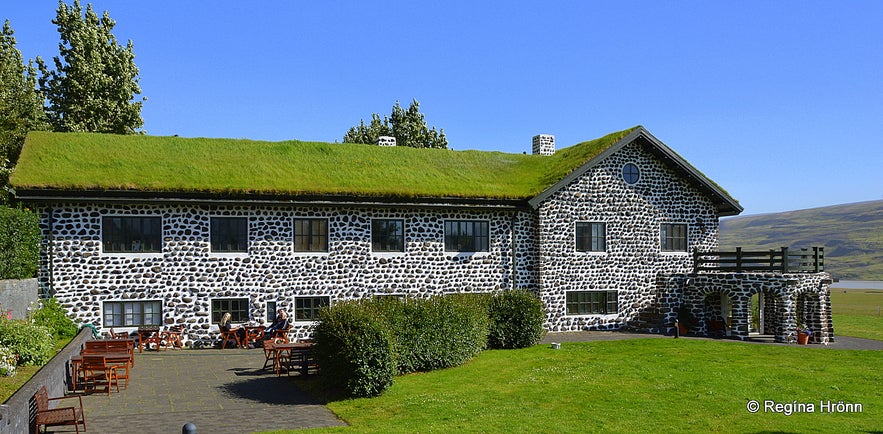
Skriðuklaustur
The ambulatory was added to the mansion in 1974-1982 and a new turf roof with a watering system was installed on the 100th anniversary of Gunnar Gunnarsson in 1989.
Gunnar had lived in Denmark for 30 years and when he returned back home to Iceland he wanted to build a European manor in the Icelandic countryside. He was born in Valþjófsdalur in Fljótsdalur in East-Iceland, where he lived for the first 7 years of his life.
He built his 325-335 sq.m. manor on the land of Skriðuklaustur very close to his birthplace.
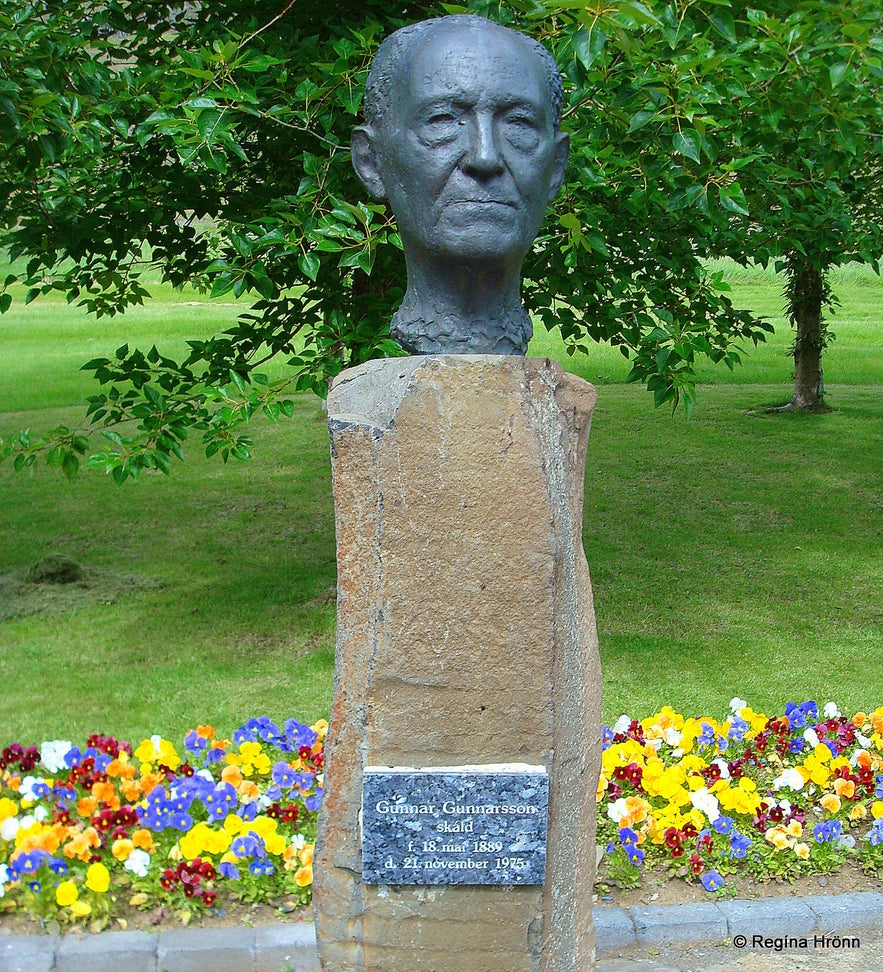
The memorial for Gunnar Gunnarsson at Skriðuklaustur
Gunnar had planned on building all in all 2,800 sq.m. with several outhouses and having large-scale farming at his big estate with up to 1,500 sheep.
He didn't manage to do so, even though some of us might think that the 350 sheep, 10 horses, 5 cows, cattle, pig, and hens he kept would be regarded as large enough.
Unfortunately, his timing was off as WW2 began and workers flocked from the countryside to the villages and towns, where there was ample and better-paid work to be had.
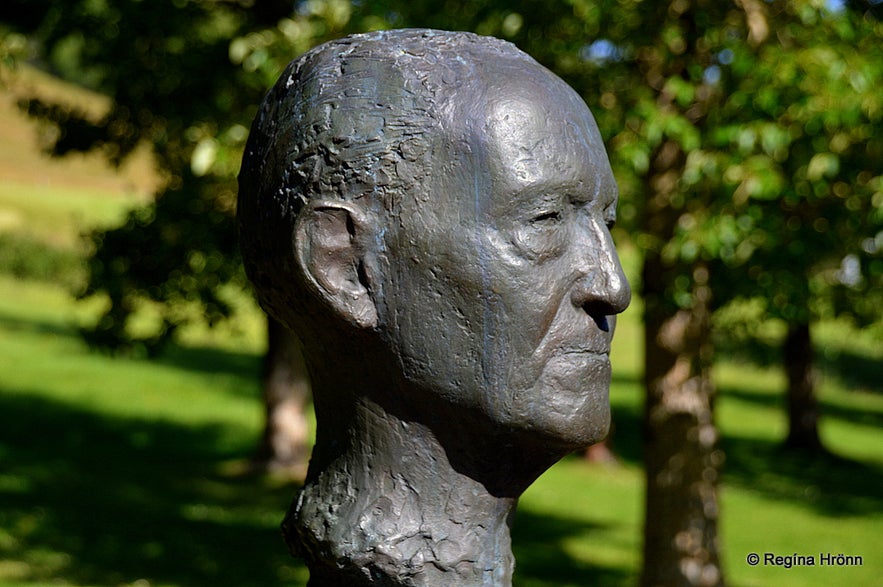
The bust of Gunnar Gunnarsson
Gunnar donated Skriðuklaustur to the Icelandic state 9 years later, in 1948, under the condition that it should be used for experimentation in farming and a residence for artists and authors.
Gunnar himself moved south to Reykjavík. At Klaustrið artists and authors can apply for a stay at the writer's retreat.
Gunnarsstofnun is dedicated to the work of Gunnar Gunnarsson and you will find a bust of Gunnar in front of his former home.
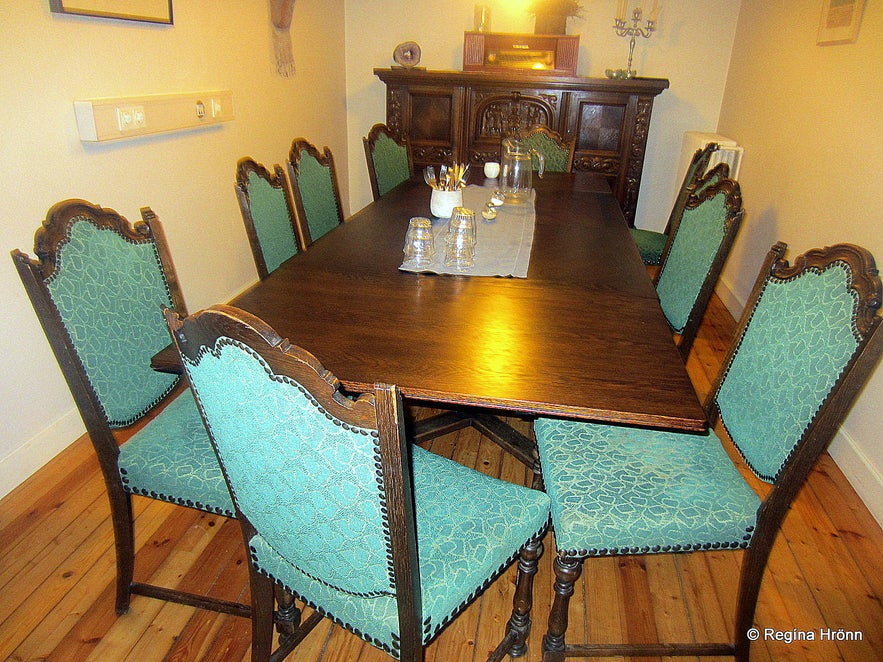
At Skriðuklaustur - I took this photo back in 2008, henge the quality of it
Gunnar Gunnarsson was a very well-known author and novelist and mainly wrote in Danish.
Amongst one of his famous works is Aðventa - the Good Shepherd. It is a very popular book, written in 1936 on the ordeal of Fjalla-Bensi, Benedikt Sigurjónsson.
Aðventa was first published in Leipzig in Germany and has since been translated into 10 languages!
Tumbi was built with turf and rock
Back in 1925, when Fjalla-Bensi was searching for left behind sheep in the highland of Iceland, he got caught in a major storm and had to stay alone with the sheep in a little hut, made of turf and stone, during the holy time of advent. Much like this little hut in my photos.
I visited this hut on my way to the Askja caldera in the highland. It is the only hut I have seen with a tree growing on top of it, quite distinctive.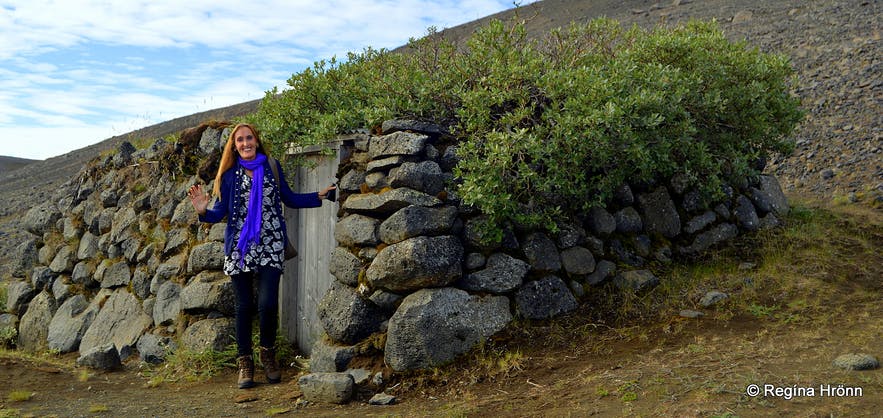
By Tumbi hut
It is cool visiting it in the summertime, but just imagine what it must have been like being stuck in an awful blizzard in the highland of Iceland alone in such huts.
Now, back to Skriðuklaustur, where exhibitions, concerts, and talks are held amongst other events.
The manor reminds me of German and Danish mansions and it is very lovely finding such a beautiful house here in East Iceland.
We have nothing else to the liking of this beautiful mansion in Iceland.
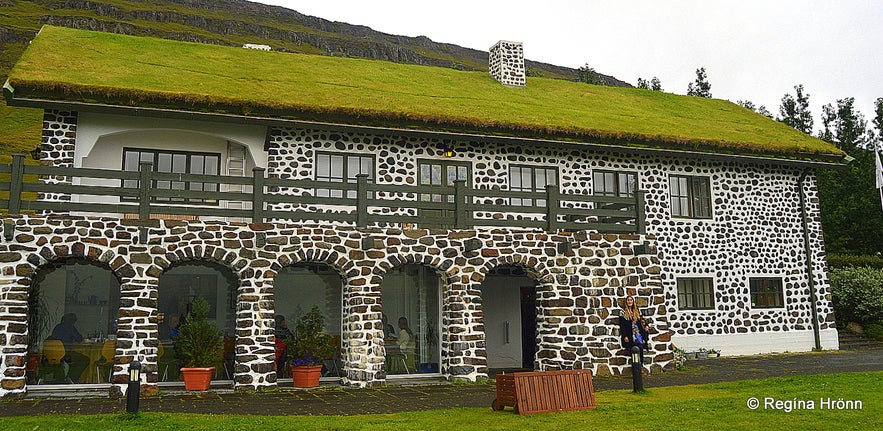
Skriðuklaustur
Skriðuklaustur has irregular opening hours, but in the summertime in June-August, it is open from 10-18. In May & September from 11-17, April from 12-16, and October 1st-15th from 12-16. These opening hours can change so check out the website of Skriðuklaustur.
If you are travelling outside of these opening hours you can phone ahead at +354 471-2990 to get a peek into this beautiful mansion.
There is an entrance fee to the museum, where you will also get guidance.
Archaeological excavations of the old monastery at Skriðuklaustur
Archaeological excavations of the old monastery at Skriðuklaustur
Beneath Gunnarshús manor at Skriðuklaustur, you will find ruins of the old monastery at Skriðuklaustur, which was operated from 1493-1552.
The archaeological excavation began in 2002 and lasted for 10 years.
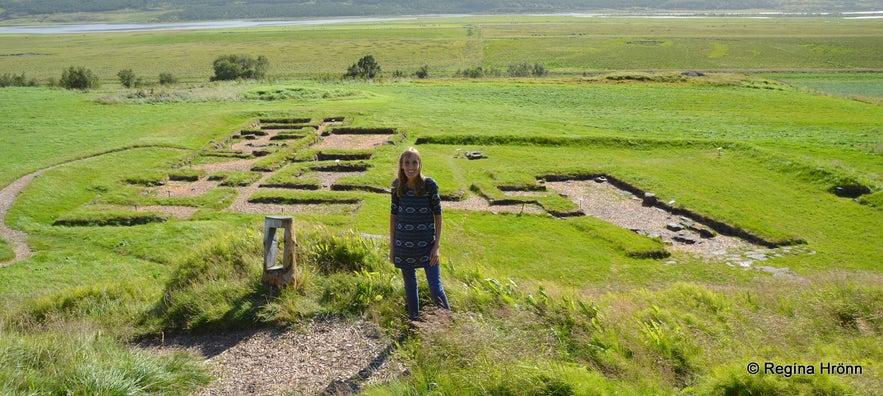
By the monastic ruins
During the archaeological excavation, old graves were dug up and the bones examined, which shed new light on the function of the monastery and the ailments of the patients at the hospital.
Around 260 skeletons were exhumed in the old cemetery.
Many of these bones show that the patients had serious illnesses; cancer, hydatid disease, smallpox, syphilis, TB, etc.
Information signs about the Archaeological excavations of the old monastery at Skriðuklaustur
Many skeletons of babies and premature babies were also exhumed.
Two of the graves in the cemetery were most likely the graves of priors, who were buried with women and children like they had been a family.

This might seem strange as the Catholic priors should have been celibate. But it seems like different rules applied here in Iceland. It was a rule rather than an exception that the clergymen had women and children.
They were not allowed to marry though, but the women were called escorts.
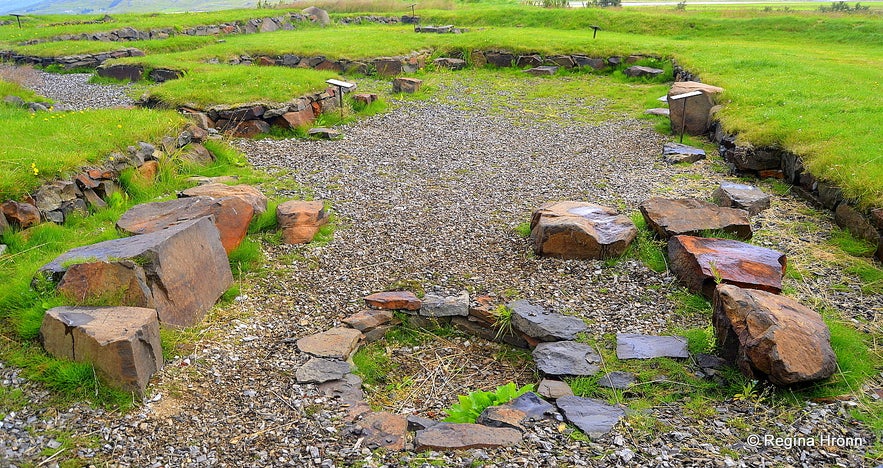
Every room of the monastery has been marked with its function and an information sign has been put up to give us a better insight into the life and work at the monastery. You can walk around this area and have a "peek" into each room.
An excellent job has been done in presenting the monastery to visitors, even though nobody knows what it looked like. This lost monastery was 1200 sq.m. in size, which is large for Iceland.
I would have loved to see what it looked like when it was operating, even though I am happy that I was not alive during the dark middle ages in Iceland.
Here you can find an infirmary, a cloister garden with a well in the centre, sleeping quarters for the monks, the quarters of the bishop, a chapel, a pantry and a dining hall, a brewery, an infirmary, and many other rooms.
The cloister church, which was consecrated in 1512, was the most important building in the monastery. Here are also night-stairs for the monks to enter the church, as they had to be able to access the church 24/7.
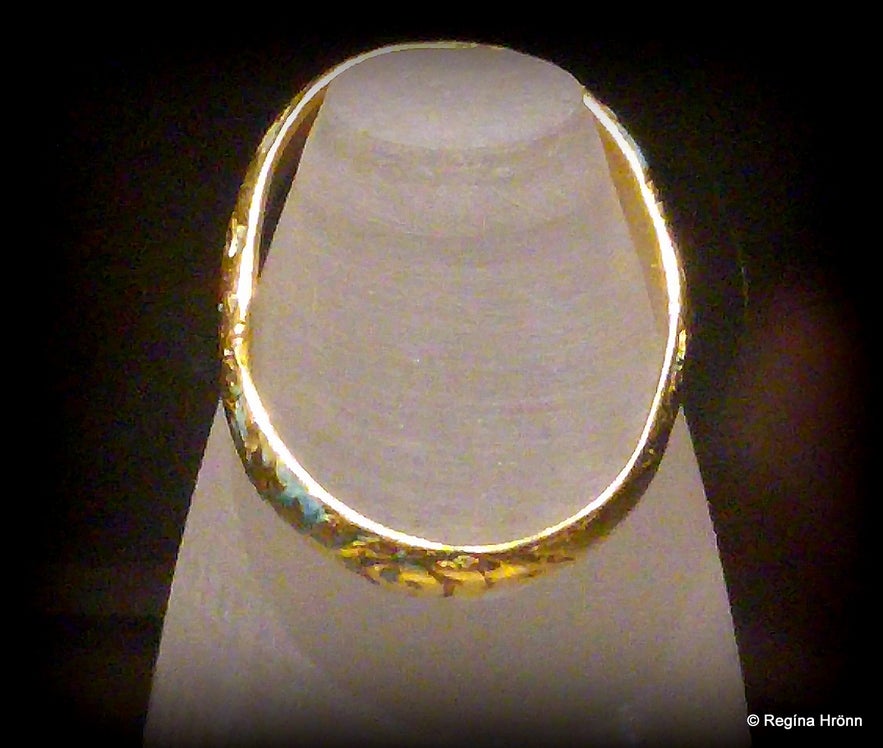
A ring found at Skriðuklalustur - very difficult to photograph through the glass
It is very interesting wandering around the different rooms, imagining what life must have been like during its time of operation.
Several objects were discovered during the excavation, including a beautiful gold ring (see my photo above), which I found on display at a temporary exhibition on monasteries in Iceland at the National Museum of Iceland.
The ring was found in a grave. It was customary for the nuns and monks to wear a golden ring as a symbol of their vow.

A figure of St. Barbara found at Skriðuklaustur
A figure of St. Barbara was also found, dating back to the 15th century, made in Utrecht in the Netherlands. The torso was found in pieces in the church and the head in the kitchen.
It might have been broken and disfigured after the adoption of Protestantism in Iceland, which was common back then.
You might notice that her symbol, the tower, is missing. St. Barbara was believed to protect against fever and sudden death. The figure was also on display at the National Museum of Iceland.
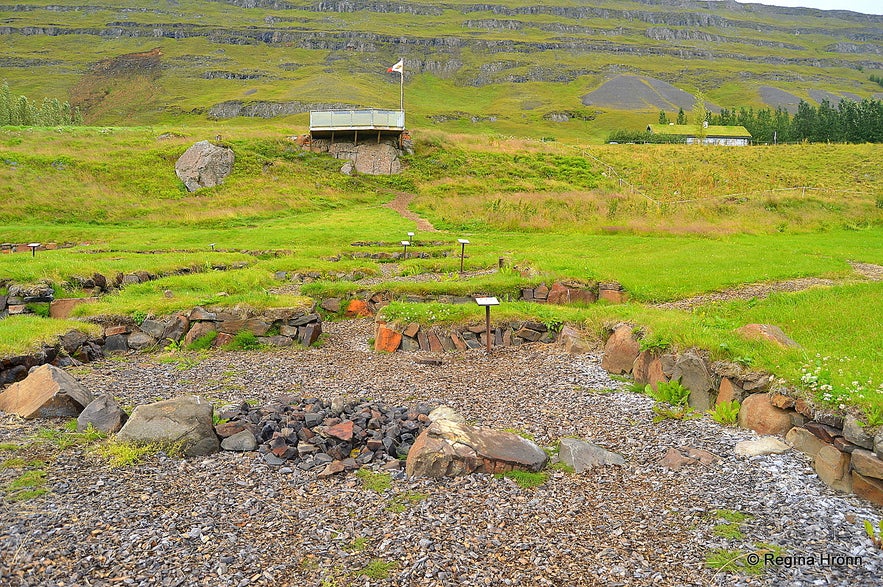
Some rosary beads were also unearthed, a knife and a chess piece to name but a few.
This is the only whole monastery, which has been excavated in Iceland and the northernmost monastery in Europe.
The grave of the vagrant Jón Hrak
The grave of the vagrant Jón Hrak at Skriðuklaustur
Only one gravestone can be found in the cemetery by Skriðuklaustur, the grave, and gravestone of the vagrant Jón Hrak.
There are many tales of this vagrant and it was believed that he was buried here in the cemetery. What is unique with his grave is that he is not buried east-west, which is customary here in Iceland, but south-north (út og suður).
The Chief Forester Hákon Bjarnason (skógræktarsjóri) had a tombstone erected on the grave. A well-known poem about Jón Hrak goes like this in Icelandic:
"Kalt er við kórbak,
kúrir þar Jón Hrak.
Ýtar snúa austur og vestur,
allir nema Jón Hrak, allir nema Jón Hrak"
- in English:
" It is cold at the choir's back,
there lies old Jón Hrak.
Everybody is buried lying East and West,
everybody but Jón Hrak, everybody but Jón Hrak".
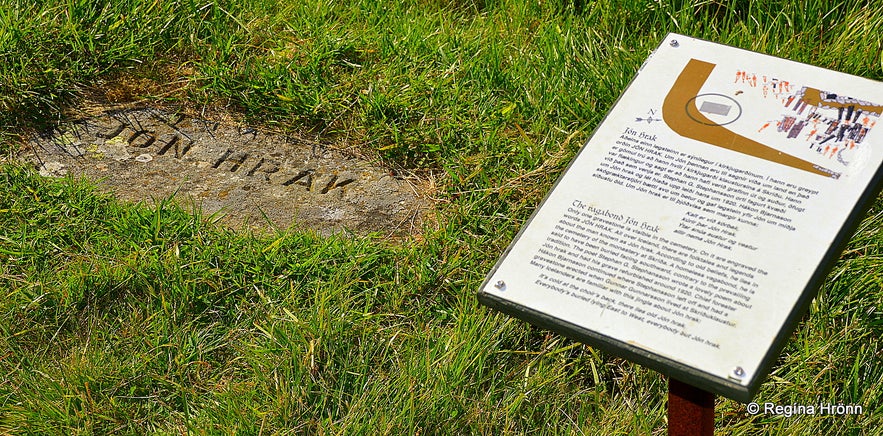
The grave of Jón Hrak
One of the reasons why Jón Hrak is believed to have been buried this way is that he was a vagrant and might have died in the dead of winter, so those who buried him didn't show him the respect of burying him in the proper manner.
Another reason might be that those, who buried him, didn't want him to return from his grave so they turned him in the "wrong" direction.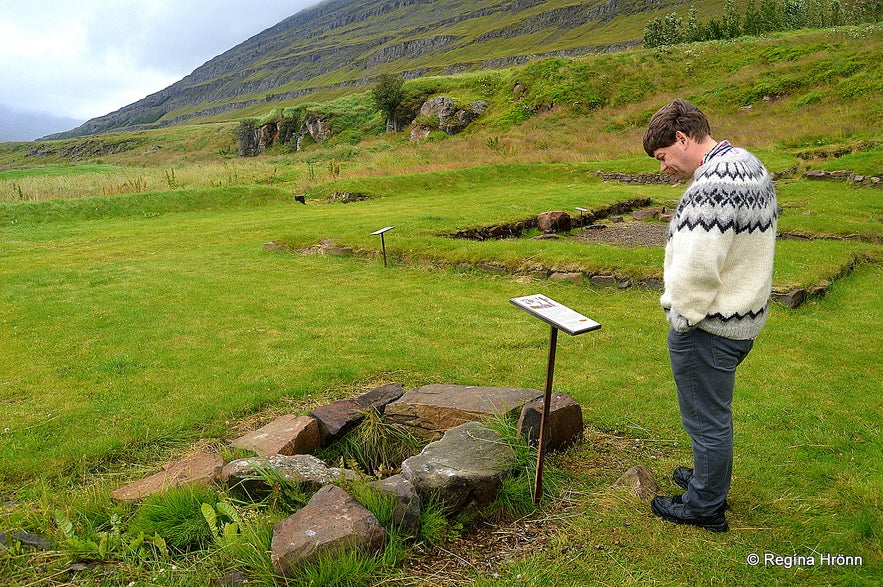
This is my Jón ;)
I found a story in Þjóðsögur Jóns Árnasonar - The Collection of Folklore of Jón Árnason, which I often refer to in my travel-blog, telling a different story of Jón "Flak" in a different cemetery with the same poem - but here Jón "Flak" is repeating this poem after his death.
So this is not carved in stone, but an interesting story all the same.
Sesselja the sinner
The information sign at Skriðuklaustur
I just want to tell you in a few words how the old land Skriða (now Klaustur) came into the possession of the Catholic church. Sesselja Þorsteinsdóttir had married her second cousin once-removed, Einar Ormsson Loftssonar the Rich. Einar died in 1470 and after his demise, the cousinship to his wife was revealed, but at this time it was forbidden for second cousins once removed to get married.
Einar's brother, Loftur, convinced the bishop to strip his brother's children of their inheritance and to excommunicate Sesselja :( The only way for Sesselja to save her soul and the soul of her now illegitimate children was to donate the land Skriða, which she had inherited from her husband to the Catholic church, for a monastery to be built there.
I got this story from an information sign on the excavation site, but have not seen it anywhere else.
Hengifoss waterfall is in the vicinity of Skriðuklaustur
From Egilsstaðir drive on ring-road 1, then take route 931 to make a round-trip from Egilsstaðir around the lake, cross the bridge and turn left on 933 for Skriðuklaustur.
To get back take 931 back to Egilsstaðir either on the same side as you arrived or drive around the lake. That road is partly gravel.
Here you can see the location of Skriðuklaustur and Snæfellsstofa on the map.
I have written other travel-blogs about interesting sights in the vicinity of Skriðuklaustur:
The majestic Hengifoss and Litlanesfoss Waterfalls in East Iceland
Hallormsstaðaskógur Forest in East Iceland - Iceland's largest Forest
Lagarfljótsormurinn Serpent in Lagarfljót Lake in East Iceland
Egilsstaðir in East Iceland and the Pearls of Fljótsdalur Valley
Have a lovely time in East Iceland :)
其他有意思的博客
冰岛最浪漫的角落
对于很多人,遥远的冰岛有着世界尽头的神秘,有着区别于巴黎、马尔代夫、自成一体的浪漫。没有埃菲尔铁塔和蒂凡尼,没有热带沙滩,而是在冰川、火山、苔藓地的背景下蜜月旅拍、婚拍,甚至举办一场冰岛婚礼。来冰岛旅行,多是要跨千山万水、飞跃大洋大陆,很有一点“万水千山陪你走过”的史诗感。难怪很多人说,光是冰岛二字,就足够浪漫了。 冰岛虽然不大,但是地貌极其丰富,不同的自然景观自然有不同的气质。这一篇,就挑阅读更多从极光观测到摄影-到底该不该来冰岛看极光
很多朋友都想来冰岛看极光,但是冰岛到底适不适合看极光呢?几月、什么季节能看到极光?是不是一定要参加北极光旅行团?如何能拍摄出美丽的极光照片呢?在冰岛住了好几年了,从刚开始逢极光必出门,到如今家里阳台就能看极光,我对在冰岛看极光的了解和经验,也算得上大半个专家了,且听我娓娓道来吧。 到底该不该来冰岛看极光呢?最坦诚的答案是,不要只为了看极光而看极光。 极光原理 太阳活动→太阅读更多
迷失冰岛的米湖游览推荐|不只有温泉的地热宝藏区
我在冬夏秋均到访过米湖,看过米湖的不同面。一直以来,米湖到底值不值得去是很多游客争论的问题。有些人觉得这里是来冰岛旅行的必去目的地,有些人则说米湖“太丑了”,连照片都不想多拍几张。那米湖到底值不值得来呢?到底怎么玩呢? 米湖的风景 北部的米湖,因地理位置相距首都雷克雅未克略远,很多来冰岛的短途游客选择放弃,其实米湖应该是和黄金圈、南岸沿线至冰湖齐名的冰岛景色,这里冷热相融,可谓最冰岛,尤其阅读更多

将冰岛最大的旅行平台下载到您的手机中,一站式管理您的整个行程
使用手机摄像头扫描此二维码,然后点击显示的链接,将冰岛最大的旅行平台添加到您的手机中。输入您的电话号码或电子邮件地址,以接收包含下载链接的短信或电子邮件。

